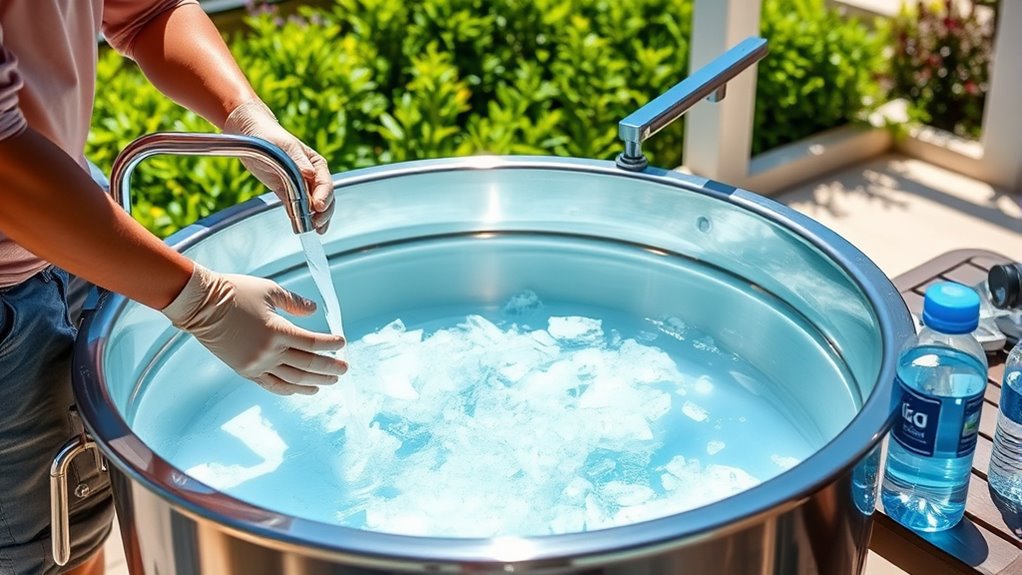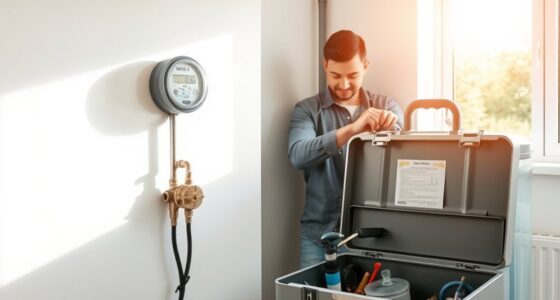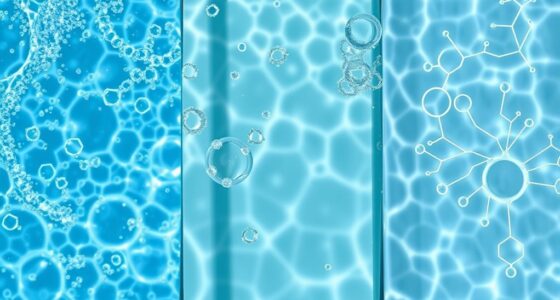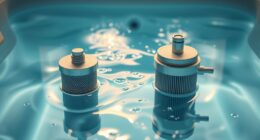To change your cold plunge water and deep clean the tank, start by turning off the filtration system, then drain the water completely using a drain valve or sump pump. Inspect the tank for mold, algae, or damage, and scrub surfaces with a pool-safe brush. Rinse thoroughly, sanitize with a suitable disinfectant, then refill the tank with clean water. Maintaining filtration and testing water regularly helps keep it safe—keep going to learn all the essential steps.
Key Takeaways
- Turn off the filtration system and drain the water completely using a drain valve or sump pump.
- Inspect the tank for mold, algae, mineral deposits, and structural damage during initial inspection.
- Deep clean surfaces with a pool-safe brush, scrub corners and seams, then rinse with clean water.
- Refill the tank, add sanitizer or water treatment, and verify the filtration system is operational.
- Regularly test water chemistry, adjust chemicals as needed, and schedule routine filter maintenance.
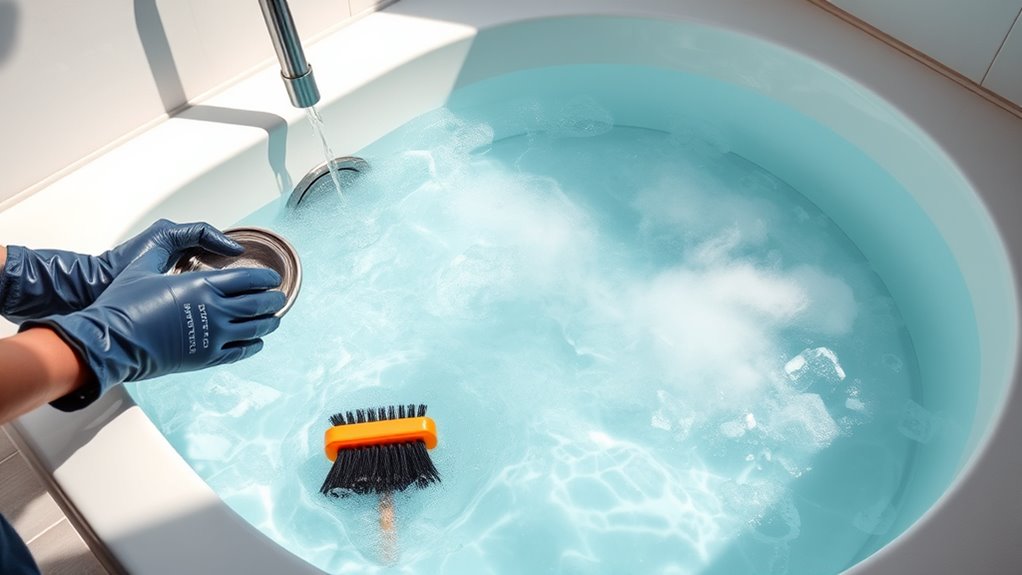
Maintaining your cold plunge pool is vital for both safety and hygiene, and knowing how to properly change the water and deep clean the tank makes the process much easier. One of the first steps is understanding the importance of water filtration. Your pool’s filtration system works continuously to keep the water clear and free of debris, bacteria, and algae. Before you begin draining, verify the filter is functioning properly, and plan to replace or clean the filter as part of your maintenance routine. Regularly scheduled filter maintenance, based on your pool’s usage, helps prevent buildup and reduces the need for frequent deep cleaning. Establishing a consistent cleaning schedule guarantees you won’t overlook essential steps and keeps your pool safe and inviting.
Regular filter maintenance keeps your cold plunge safe, clean, and inviting.
When it’s time to change the water, start by turning off the filtration system. Drain the pool using the drain valve or a sump pump, making sure to remove all water from the tank. Once emptied, inspect the tank for any signs of mold, algae, or mineral deposits. Use a brush designed for pool cleaning to scrub the surfaces thoroughly, paying close attention to corners and seams. This deep clean removes residues that filtration might miss and prevents buildup that could harbor bacteria. Additionally, inspecting the tank for structural damage or leaks ensures long-term durability and safety.
After cleaning, rinse the tank with clean water to wash away loosened debris and soap residues. It’s vital to sanitize the tank during this process — you can use a mixture of water and a safe, pool-approved disinfectant or vinegar solution. Wipe down all surfaces to eliminate germs and verify the tank is thoroughly sanitized before refilling. When refilling, consider adding a water treatment or sanitizer compatible with your pool system, and double-check your water filtration system to verify it’s back on and functioning correctly.
To keep your pool’s water fresh and safe, create a routine that includes regular water testing and chemical balancing. Test the water at least once a week, and adjust pH, sanitizer levels, and alkalinity as needed. This routine, combined with your scheduled deep cleans, helps maintain ideal water quality and extends the lifespan of your pool components. Remember, a well-maintained cold plunge not only provides a safe and hygienic experience but also reduces the frequency of full water changes, saving you time and effort in the long run. By adhering to a disciplined cleaning schedule and paying attention to your filtration system, you’ll keep your cold plunge in top condition for years to come.
Frequently Asked Questions
How Often Should I Change the Cold Plunge Water?
You should change your cold plunge water every 4 to 6 weeks, depending on usage. Regular water testing helps you monitor pH and sanitizer levels to keep it clean. Don’t forget filter maintenance—clean or replace filters regularly to prevent buildup. If you notice cloudiness, odors, or increased water testing issues, change the water sooner. Staying attentive ensures a safe, invigorating experience every time you use your plunge.
Can I Use Regular Household Cleaning Products?
Did you know that using inappropriate cleaning products can increase bacteria by 80%? You shouldn’t use regular household cleaners or chemical alternatives in your cold plunge. These products can damage the pool’s surface and introduce harmful residues. Instead, opt for gentle, non-toxic cleaners specifically made for pools or disinfect with mild vinegar solutions. Always rinse thoroughly to keep your cold plunge safe, clean, and ready for use.
What Is the Best Way to Disinfect the Tank?
You should use a disinfectant specifically designed for water tanks to guarantee sanitizer effectiveness. First, drain the tank and clean it thoroughly, then add a suitable water sanitizer, like chlorine bleach, following the manufacturer’s instructions. Make sure your water filtration system is working properly, as it helps maintain clean water. This combination ensures the tank is properly disinfected, reducing bacteria and maintaining a safe, hygienic environment for your cold plunge.
Are There Eco-Friendly Options for Water Disposal?
Think of eco-friendly disposal options as a gentle breeze guiding your responsible choices. You can opt for sustainable alternatives like using biodegradable water treatment products or repurposing cold plunge water for watering plants, if safe. Check local regulations for eco-friendly disposal methods, such as draining into designated facilities or using filtration systems. These choices help protect our environment while ensuring your water management remains sustainable and thoughtful.
How Do I Prevent Algae Buildup Between Cleansings?
To prevent algae buildup between cleansings, you should focus on algae prevention by maintaining proper water circulation. Regularly run your cold plunge pump to keep water moving, which discourages algae growth. Additionally, consider using an algae-preventive treatment or a UV sterilizer. Keeping the water balanced with appropriate pH levels and avoiding direct sunlight also helps inhibit algae growth, ensuring your plunge stays clean and fresh longer.
Conclusion
Now that you’ve mastered changing your cold plunge water and deep cleaning like a pro, you’re basically a sanitation superhero! No germs stand a chance against your mighty cleaning skills, and your plunge will stay crystal clear and ice-cold forever. Get ready to impress everyone with your spotless, invigorating oasis—your friends will think you’ve discovered the fountain of youth! Keep up the great work, and your cold plunge will be the envy of every wellness enthusiast on the planet!
